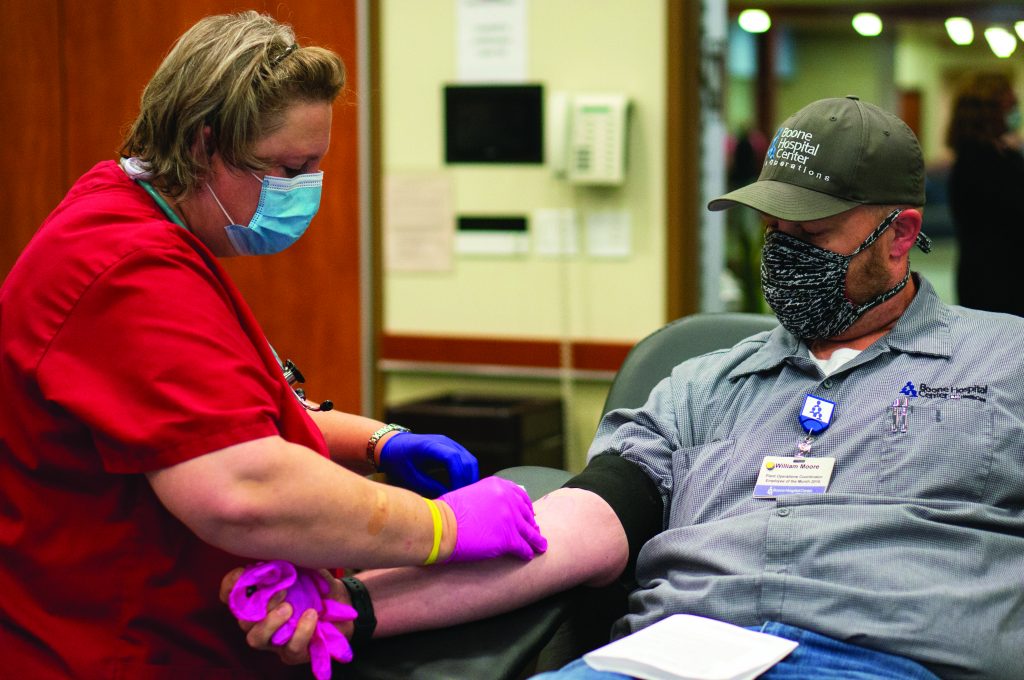
A Life-Saving Journey
By Erin Wegner
Every year, over 5,000 blood products from the American Red Cross, including whole blood, plasma, platelet, and Power Red donations, are used to help Boone Hospital Center patients. Boone Hospital has hosted blood drives for the American Red Cross for 16 years. These blood drives are one way we support Red Cross, which delivers blood products to hospitals all over the country.
The American Red Cross is broken into regions all over the United States. “Boone County and Boone Hospital are part of the Missouri-Illinois Blood Services Region. This is part of a 64-hospital network that we provide blood to. In order to provide blood year-round to our 64-hospital network, we have to collect over 214,000 blood donations yearly,” says Joe Zydlo, external communications manager for American Red Cross.
Blood can be donated at Red Cross blood drives or at a Red Cross donation center. There are also several types of donations you can make to help patients.
Whole Blood
Whole blood donation is what you typically give at a blood drive. The benefit of whole blood is its versatility — it can be transfused into a patient or separated at the processing center into red cells, plasma, and platelets.
Whole blood transfusions are usually given to trauma and surgery patients.
Power Red Donation
Power Red donations can also be done at a blood drive. As you donate, your red blood cells are separated from the other blood components, and your plasma and platelets are put back into your body. This donation takes a little longer than whole blood.
Power Red donations are usually given to trauma patients, newborns and birthing mothers, people with sickle cell anemia, and patients suffering from blood loss.
Platelet Donation
Platelet donations must be done at a Red Cross donation center using a special apheresis machine. Platelets are important, tiny cells in our blood that help us stop bleeding by forming clots. As blood is drawn from your arm, the apheresis machine keeps the platelets and returns your red blood cells and plasma.
Platelet donations are usually given to surgery patients, cancer patients, organ transplant patients, and others with life threatening injuries.
Plasma Donation
Plasma donations must be given at a donation center. A special machine also separates your blood, but keeps the plasma and returns your red blood cells and platelets.
Plasma transfusions are usually used to stop bleeding in emergency and trauma patients.
After your donation, your blood goes on a life-saving journey.
Step One: Donation
When you donate at a blood drive or Red Cross donation center, they will collect one pint, plus several test tubes of your blood.
After your donation is completed, your donated blood and test tubes are labeled and kept on ice. “Blood is a perishable product, so it is very important to do this so that the products don’t spoil,” says Joe.
Your blood is driven to St. Louis for testing.
Step Two – Testing
Testing is an important measure done with every blood donation. The test tubes go to a laboratory where several tests are done to look for infectious diseases and to verify blood type.
If there are any positives for infectious disease, donors are confidentially notified that their donation cannot be used.
Step Three – Processing
Once donated blood arrives at the processing center, whole blood donations are spun in centrifuges, which separate the blood into red blood cells, plasma, and platelets.
The standard measurement for blood is a unit. Each component of donated blood that can be used is packaged as a unit, then stored.
Step Four – Storage
Once a unit is ready to be used, it may either be packed on ice and delivered to a hospital or stored at -2° in the Red Cross cooler until it is needed.
Step Five – Distribution
“Blood is available to be shipped to hospitals 24 hours a day, seven days a week,” says Joe. The Red Cross has volunteer transportation specialists who deliver blood units to the 64-hospital network.
Step Six – Transfusion
A doctor determines that a patient needs a transfusion and what blood product is required.
Boone Hospital’s Blood Bank keeps over 130 units of various blood types and products on hand to ensure we can care for our patients. Orders are placed daily with the Red Cross to maintain inventory levels. Special blood products can be ordered for patients as needed.
Once a transfusion order has been received, the blood is picked up from the Blood Bank by a clinician and delivered to the bedside.
The entire transfusion process must occur within four hours of pickup. Many checks and balances take place along the way — these essential steps ensure patients receive compatible blood products.
Today, you can even track where your blood goes when you make an appointment through the Red Cross Blood Donor App or online at redcrossblood.org. Joe says: “You’re made aware of when and where your blood donation was delivered. I know it always makes me feel better knowing where my blood went.”
You may receive emails or hear radio advertisements from the Red Cross stating there is an urgent need for blood. Someone in the United States needs blood every two seconds, and the only way to get blood for patients is through donations.
Because blood is an essential resource that can only be provided through donors when donation drives aren’t successful, hospitals suffer. Peggy Martin, medical technologist and Blood Bank specialist at Boone says, “Since the American Red Cross supports hospitals all over the country, people may not understand that our blood supply here, locally, decreases when other blood drives across the nation do not occur.”
A single blood donation can save the lives of up to three people. If you are able, please consider donating blood. You can make an appointment to donate at a nearby drive or collection center using the Red Cross Blood Donor App, online at redcrossblood.org or by calling 1-800-RED-CROSS.